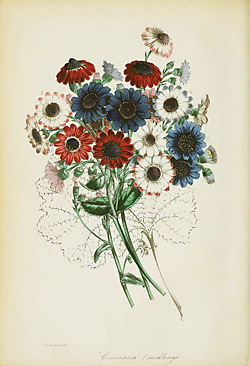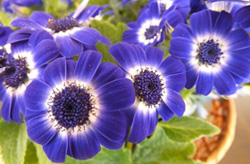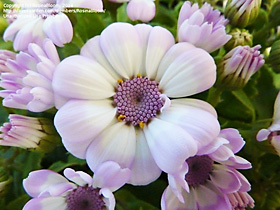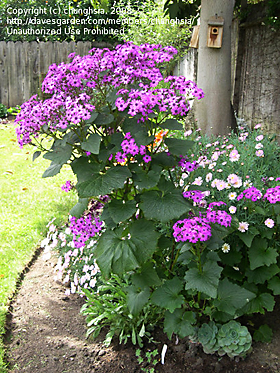





When is a daisy not a daisy?
Although we usually associate daisies with the sun and warmth of early summer, one brightly-hued variety prefers spring chill and shade. Okay, florist's cineraria (Senecio cruentus or Pericallis cruenta) actually isn’t a daisy, but its clustered 3 to 5-inch blooms resemble that flower, even though its lower leaves are large and heart-shaped.
 It usually is sold as a late winter- or spring-blooming annual and trashed after it blooms. However, this native of islands in the eastern Atlantic actually can be hardy in USDA zones 9 through 11, especially in coastal locations which meet its requirements.
It usually is sold as a late winter- or spring-blooming annual and trashed after it blooms. However, this native of islands in the eastern Atlantic actually can be hardy in USDA zones 9 through 11, especially in coastal locations which meet its requirements.
 In the San Francisco Bay area, for example, the plant experiences the cool temperatures and foggy, frost-free conditions that keep it perennially happy. In such a climate, it can bloom for most of the year.
In the San Francisco Bay area, for example, the plant experiences the cool temperatures and foggy, frost-free conditions that keep it perennially happy. In such a climate, it can bloom for most of the year.
Although it likes a bit of chill, a hard freeze will kill it. So be sure to protect your cineraria when temperatures are predicted to fall below 28 degrees Fahrenheit.
 It also likes light, rich, slightly acidic soil which stays damp and a position in either partial shade or bright, indirect light. Under those conditions, the plant will self-seed heavily, but the offspring of a dwarf hybrid may revert to a larger size. So cineraria can range in height from 6 inches to 3 feet.
It also likes light, rich, slightly acidic soil which stays damp and a position in either partial shade or bright, indirect light. Under those conditions, the plant will self-seed heavily, but the offspring of a dwarf hybrid may revert to a larger size. So cineraria can range in height from 6 inches to 3 feet.
The plant’s large leaves reportedly make it attractive to slugs, cabbage worms, leaf miners, and aphids. It’s a good idea, therefore, to keep an eye on your cineraria’s foliage and never allow it to wilt, as such stress renders it more vulnerable to pests
Even if you can’t convince your plant to hang around until the spring following its purchase, you should be able to make it flower more than once during the spring of its purchase. To do so, after your cineraria has stopped blooming, simply cut it back by about half. It then should perform again, provided that temperatures don’t climb too high in the meantime.
 The plant prefers conditions in the 45 to 55 degree Fahrenheit range. Once the mercury reaches 80 degrees F., it usually stops blooming—at least temporarily. When kept in a cool enough location over summer, it may favor you with an encore performance during autumn.
The plant prefers conditions in the 45 to 55 degree Fahrenheit range. Once the mercury reaches 80 degrees F., it usually stops blooming—at least temporarily. When kept in a cool enough location over summer, it may favor you with an encore performance during autumn.
If you want to try growing the plant from seeds, sow those seeds in late summer, pressing them into the surface of seed-starting mix. As Liberty Hyde Bailey reports in The Standard Cyclopedia of Horticulture, "Although one may save one's own seed, the cinerarias, like most hybrids, will deteriorate both in size and quality of the flower after one or two generations unless they are crossed."
The seeds usually germinate in 1 to 3 weeks and the seedlings will bloom about 4 months or so after their sowing. Be careful to slip the spout of your watering can beneath the leaves when irrigating the plants, rather than pouring water directly into their crowns, which may cause rot.
In the "loves me," "loves me not" parlance of daisies, keep in mind that if cineraria doesn't love you, it's nothing personal. The plant just may be making heavy weather of your weather!
Photos: The banner photo is by dawndoll2, the second and third photos by RosinaBloom and the final photo by chunghsia, all from the Dave's Garden PlantFiles. The antique image is from an 1839 issue of the Magazine of Botany and Register of Flowering Plants, courtesy of plantillustrations.org.
Copyright © www.100flowers.win Botanic Garden All Rights Reserved